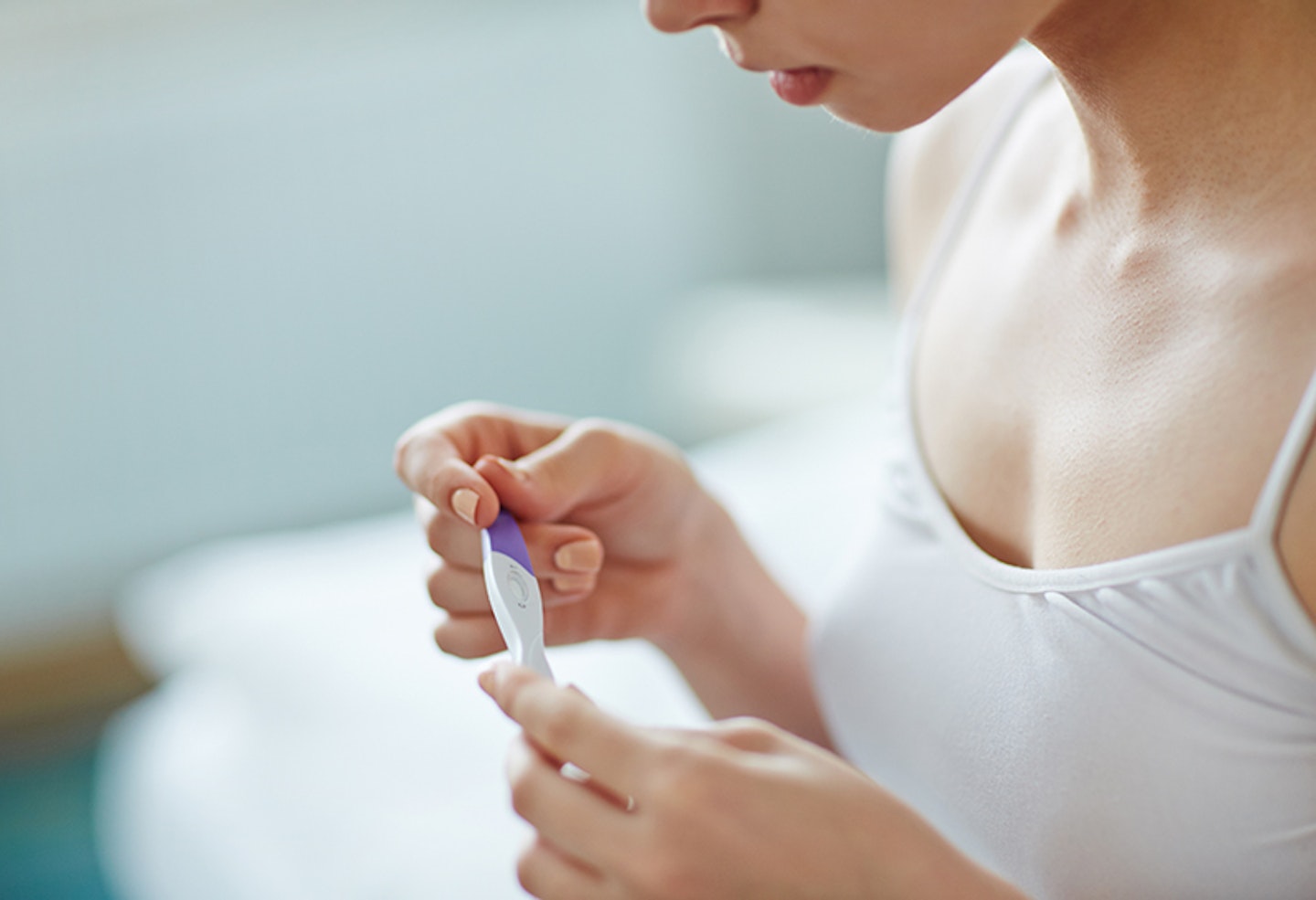If you're trying to conceive and have been reading up on the early symptoms of pregnancy, and have spotted brown discharge before your period you may be wondering if it's normal or if you could be pregnant.
You may have noticed this brown vaginal discharge or spotting a couple of days before your period is due, or even seen brown discharge a week before your usual period. If you have noticed a change in your usual menstrual cycle it's natural to check everything is working as it should. We've spoken to Rachel Fitz-Desorgher to find out more about brown discharge before a period.
What is brown discharge?
Brown vaginal discharge is caused by old menstrual blood - the lining of your womb or endometrium - that has oxidised. Our expert, Rachel Fitz-Desorgher notes that this can be caused by some of the lining of your womb sticking around after your period, before being contracted out by your uterus in preparation for your next period. This is why brown discharge can be a sign of period. Most of the time it's completely normal to see brown discharge as part of your menstrual cycle but there are a few things that can cause this kind of spotting.

What causes brown discharge?
Periods
Brown discharge before or after your period is very common, it's just your uterus clearing itself out. Rachel Fitz-Desorgher notes that your uterus clears out any lining of the womb that might have been left after your last period before the new also starts to come away. So before your period this will be old blood from your last cycle, and after your period is just those last few clear outs. For a similar reason you may see pink discharge at the start or end of your cycle, which is a little blood mixed with your clear vaginal discharge.
Implantation bleeding
Implantation bleeding doesn't have a specific colour, but is normally light and can result in a brown hue. This occurs when a fertilised egg attaches to the uterine lining. As it does, it creates a small amount of bleeding. Confusingly, it normally occurs at the time of your usual period, so if this bleeding is different from what's normal for you, or you experience brown discharge combined with other early pregnancy symptoms it could be worth taking a pregnancy test. Rachel does note that it is possible to have a False Negative pregnancy test so it could be worth waiting until your period is actually due before testing. Read on for more information on implantation bleeding.
Ectopic pregnancy
A brown watery vaginal discharge, in rare cases, could be a sign of an ectopic pregnancy. Other symptoms include pain low down and on one side of your abdomen, bleeding, shoulder pain, and discomfort when going to the toilet.
Miscarriage
The most common sign of miscarriage is vaginal bleeding. This can vary from light spotting or brownish discharge to heavy bleeding and bright-red blood or clots. The bleeding may come and go over several days.
However, light vaginal bleeding is relatively common during the first trimester (first 3 months) of pregnancy and does not necessarily mean you're having a miscarriage. If you're worried, always speak to your midwife or GP.
Ovulation
Brown spotting is often just a sign of ovulation or your actual period starting. This is totally normal and nothing to be concerned about. Ovulation occurs when your estrogen levels are high. These levels drop after the egg is released. The decrease in estrogen can cause some bleeding and spotting. To check if it is ovulation, you can use an ovulation calculator or test kit.
Polycystic ovary syndrome
Polycystic ovary syndrome (PCOS) can lead to irregular or infrequent menstrual periods, with more than 35 days between each period. This extended time between periods can result in brown discharge. You might also experience ovarian cysts and brown discharge between periods due to missed ovulation.
Hormonal birth control (breakthrough and withdrawal bleedings)
The most common side effect of using birth control pills is breakthrough bleeding in the first several months. You may even notice that the blood you see is dark brown, which may mean that it's old blood.
Adenomyosis
Adenomyosis is a condition that causes the lining of the womb (the endometrium) to bury into the muscular wall of the womb. According to the NHS, symptoms can include heavy periods, cramping, painful sex and infertility. It's common to see spotting between periods, which is normally dark brown.
Endometrial or cervical polyps
Polyps do not cause pain, but they can lead to menstrual pain by causing irregularities in bleeding. Polyps may also manifest themselves with brown discharge observed before and after menstruation.
Sexually transmitted infections
Some STIs, such as chlamydia or gonorrhoea, can cause you to have brown discharge or spotting when you don't have your period. Other symptoms include vaginal discharge with an unpleasant odour, pain during sex, and a burning sensation when urinating.
Perimenopause
Oestrogen maintains the lining of the uterus. Menstruation occurs when the lining of the uterus, also known as your period, leaves the body. When oestrogen levels are in flux, as expected in perimenopause, this lining may break down at different times, and if it sits around for a while it results in brown blood. Other symptoms could include mood changes, hot flushes, night sweats, trouble sleeping and vaginal dryness.
Is it normal to have brown discharge before your period?
Rachel notes that "most women will have a light 'pink' discharge before their period, but for some women this will show as brown". The lining of the womb (endometrium) which comes away during your period is tissue and as this starts to come away it can be brown. Equally, it can also be brown towards the end of your period as it's been around for a few days and has oxidised. If any of this endometrium is left behind in the uterus at the end of your period, it may well come away before your next period and this will show as a brown discharge and a sign your period could be on its way.

Brown discharge before period, could I be pregnant?
While it's not a definite sign of pregnancy, as there are lots of other causes for brown discharge, and as mentioned above it could be implantation bleeding. Rachel notes that this happens when the fertilised egg settles into and under the top layer of the endometrium or womb lining and causes a little bleeding. This usually happens 10 to 14 days after conception and can be brownish in colour. So Rachel says that if you've had unprotected sex, and have brownish discharge around halfway through your cycle that doesn't turn into a period, you may want to test. “Test, don’t guess” is the mantra in all areas of hormonal changes. You can also experience brown discharge during pregnancy which may have several possible causes.
When should I be concerned about brown discharge?
Rachel notes that while it's not uncommon to have a small amount of brown discharge before your period, there are some reasons it can be a cause for concern. She notes this is particularly the case if it's unusual for you.
The list below contains some symptoms that occur with brown bleeding that could be a sign of a more serious problem and would require a call to your GP.
Brown bleeding that:
• smells bad
• if it carries on and doesn't turn into a period
• is associated with a fever
• is associated with pain and cramping after period
If your brown discharge is accompanied by any of these symptoms or is unusual for your body, Rachel recommends talking to your doctor to get it checked out.
About the Expert
Rachel Fitz-D is an active birth teacher, parenting consultant and author of Baby Skin To Skin, with over 30 years working as a midwife and as a parenting consultant. Based in Berkshire, near London, she has appeared on numerous radio programmes, talking about various issues from infant feeding to smacking to humanist parenting. She co-created Henley Birthcare, a unique freelance midwifery and doula service offering bespoke care.
Stephanie Spencer is the Hub Editor at Mother&Baby and auntie to four aged 8 to 6 months old. With a particular interest in health, she loves discovering products that make parent’s lives easier.
